Motivation Theories and Their Application within the Modern Workplace
VerifiedAdded on 2023/06/18
|7
|2222
|310
Essay
AI Summary
This essay delves into the concept of motivation, exploring its significance in enhancing individual and organizational performance within the modern workplace. It discusses various motivational theories, including Maslow's hierarchy of needs, Alderfer's ERG theory, Herzberg's two-factor theory, Skinner's reinforcement theory, and Victor Vroom's expectancy theory, highlighting their contributions to understanding employee motivation. The essay emphasizes the shift towards a modern workplace that prioritizes employee satisfaction, productivity, and engagement. It introduces the 3Cs motivation paradigm (Career, Community, and Cause) as a framework for fostering motivation in contemporary work environments, suggesting that aligning employee aspirations with organizational objectives and creating a supportive community are crucial for maximizing employee potential and overall success. While Maslow's theory is foundational, the essay concludes that the 3Cs model is more applicable in today's work environment.
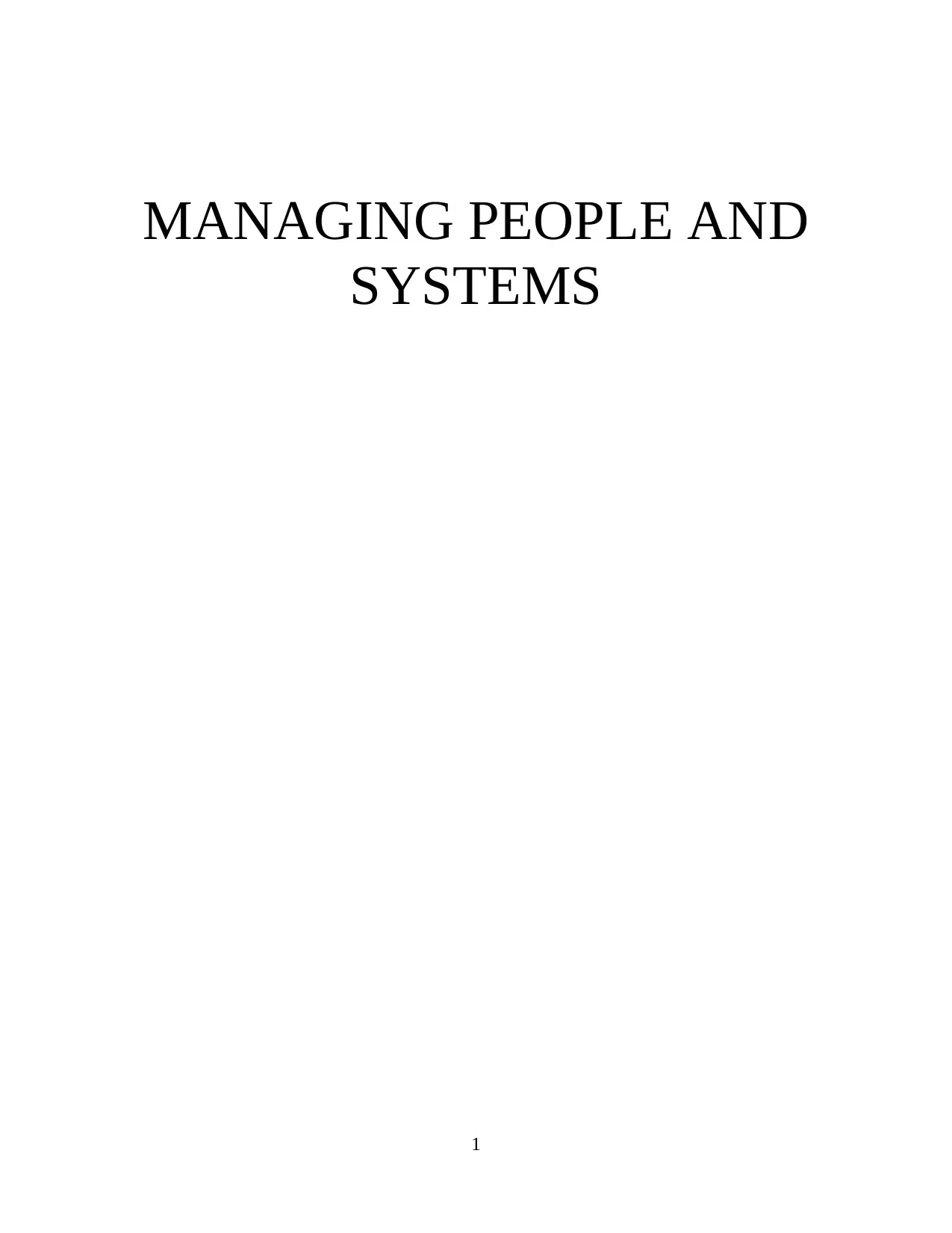
MANAGING PEOPLE AND
SYSTEMS
1
SYSTEMS
1
Paraphrase This Document
Need a fresh take? Get an instant paraphrase of this document with our AI Paraphraser
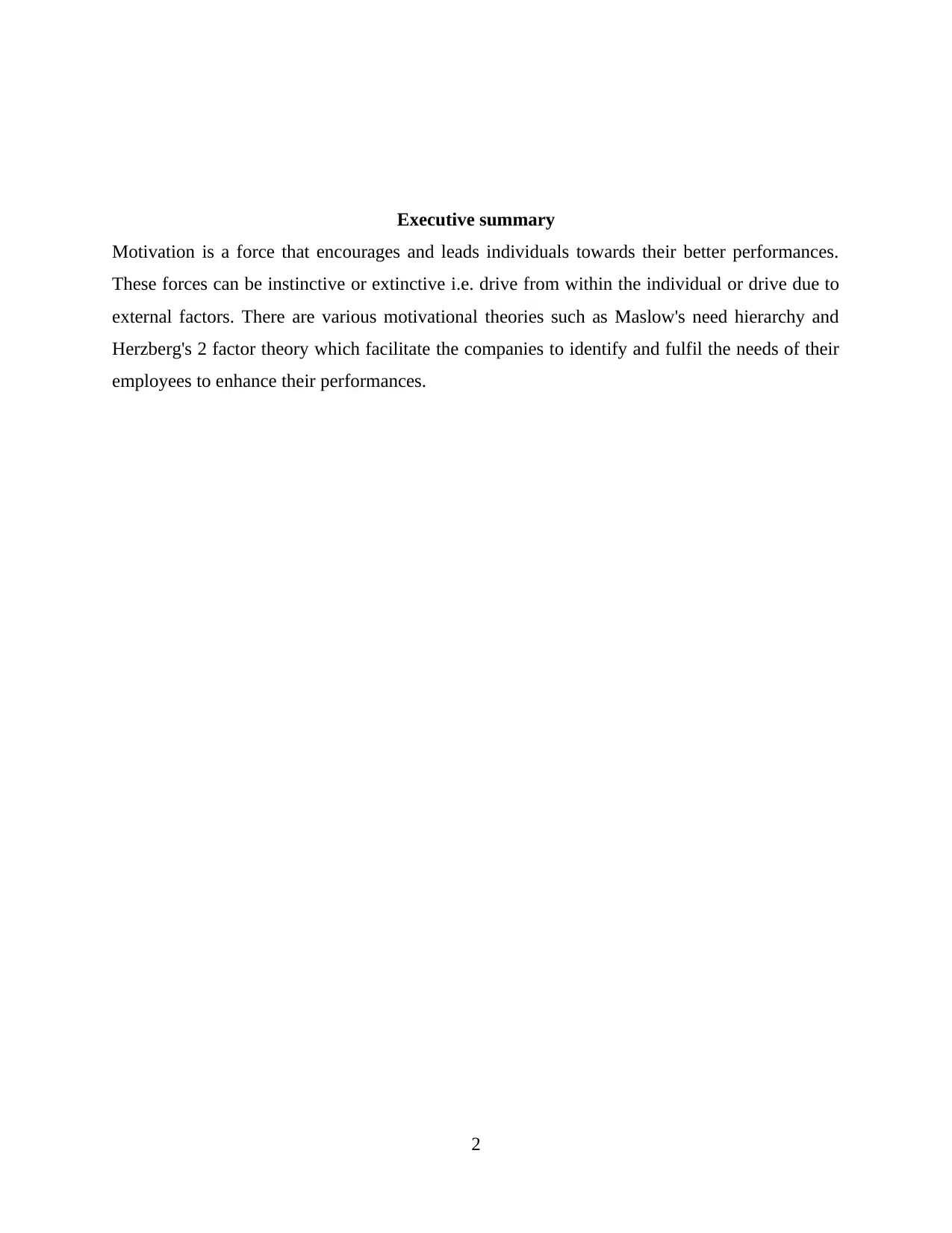
Executive summary
Motivation is a force that encourages and leads individuals towards their better performances.
These forces can be instinctive or extinctive i.e. drive from within the individual or drive due to
external factors. There are various motivational theories such as Maslow's need hierarchy and
Herzberg's 2 factor theory which facilitate the companies to identify and fulfil the needs of their
employees to enhance their performances.
2
Motivation is a force that encourages and leads individuals towards their better performances.
These forces can be instinctive or extinctive i.e. drive from within the individual or drive due to
external factors. There are various motivational theories such as Maslow's need hierarchy and
Herzberg's 2 factor theory which facilitate the companies to identify and fulfil the needs of their
employees to enhance their performances.
2
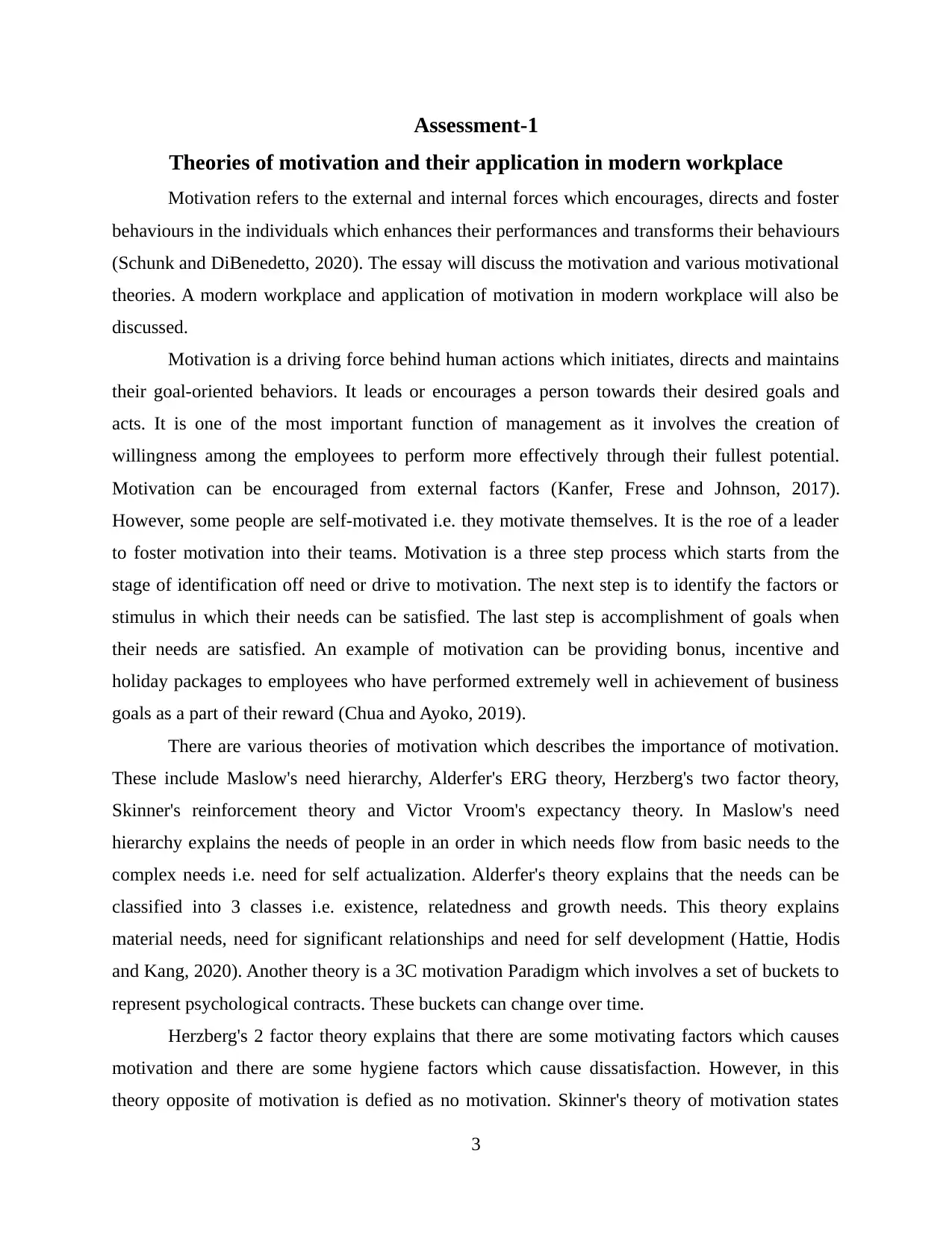
Assessment-1
Theories of motivation and their application in modern workplace
Motivation refers to the external and internal forces which encourages, directs and foster
behaviours in the individuals which enhances their performances and transforms their behaviours
(Schunk and DiBenedetto, 2020). The essay will discuss the motivation and various motivational
theories. A modern workplace and application of motivation in modern workplace will also be
discussed.
Motivation is a driving force behind human actions which initiates, directs and maintains
their goal-oriented behaviors. It leads or encourages a person towards their desired goals and
acts. It is one of the most important function of management as it involves the creation of
willingness among the employees to perform more effectively through their fullest potential.
Motivation can be encouraged from external factors (Kanfer, Frese and Johnson, 2017).
However, some people are self-motivated i.e. they motivate themselves. It is the roe of a leader
to foster motivation into their teams. Motivation is a three step process which starts from the
stage of identification off need or drive to motivation. The next step is to identify the factors or
stimulus in which their needs can be satisfied. The last step is accomplishment of goals when
their needs are satisfied. An example of motivation can be providing bonus, incentive and
holiday packages to employees who have performed extremely well in achievement of business
goals as a part of their reward (Chua and Ayoko, 2019).
There are various theories of motivation which describes the importance of motivation.
These include Maslow's need hierarchy, Alderfer's ERG theory, Herzberg's two factor theory,
Skinner's reinforcement theory and Victor Vroom's expectancy theory. In Maslow's need
hierarchy explains the needs of people in an order in which needs flow from basic needs to the
complex needs i.e. need for self actualization. Alderfer's theory explains that the needs can be
classified into 3 classes i.e. existence, relatedness and growth needs. This theory explains
material needs, need for significant relationships and need for self development (Hattie, Hodis
and Kang, 2020). Another theory is a 3C motivation Paradigm which involves a set of buckets to
represent psychological contracts. These buckets can change over time.
Herzberg's 2 factor theory explains that there are some motivating factors which causes
motivation and there are some hygiene factors which cause dissatisfaction. However, in this
theory opposite of motivation is defied as no motivation. Skinner's theory of motivation states
3
Theories of motivation and their application in modern workplace
Motivation refers to the external and internal forces which encourages, directs and foster
behaviours in the individuals which enhances their performances and transforms their behaviours
(Schunk and DiBenedetto, 2020). The essay will discuss the motivation and various motivational
theories. A modern workplace and application of motivation in modern workplace will also be
discussed.
Motivation is a driving force behind human actions which initiates, directs and maintains
their goal-oriented behaviors. It leads or encourages a person towards their desired goals and
acts. It is one of the most important function of management as it involves the creation of
willingness among the employees to perform more effectively through their fullest potential.
Motivation can be encouraged from external factors (Kanfer, Frese and Johnson, 2017).
However, some people are self-motivated i.e. they motivate themselves. It is the roe of a leader
to foster motivation into their teams. Motivation is a three step process which starts from the
stage of identification off need or drive to motivation. The next step is to identify the factors or
stimulus in which their needs can be satisfied. The last step is accomplishment of goals when
their needs are satisfied. An example of motivation can be providing bonus, incentive and
holiday packages to employees who have performed extremely well in achievement of business
goals as a part of their reward (Chua and Ayoko, 2019).
There are various theories of motivation which describes the importance of motivation.
These include Maslow's need hierarchy, Alderfer's ERG theory, Herzberg's two factor theory,
Skinner's reinforcement theory and Victor Vroom's expectancy theory. In Maslow's need
hierarchy explains the needs of people in an order in which needs flow from basic needs to the
complex needs i.e. need for self actualization. Alderfer's theory explains that the needs can be
classified into 3 classes i.e. existence, relatedness and growth needs. This theory explains
material needs, need for significant relationships and need for self development (Hattie, Hodis
and Kang, 2020). Another theory is a 3C motivation Paradigm which involves a set of buckets to
represent psychological contracts. These buckets can change over time.
Herzberg's 2 factor theory explains that there are some motivating factors which causes
motivation and there are some hygiene factors which cause dissatisfaction. However, in this
theory opposite of motivation is defied as no motivation. Skinner's theory of motivation states
3
⊘ This is a preview!⊘
Do you want full access?
Subscribe today to unlock all pages.

Trusted by 1+ million students worldwide
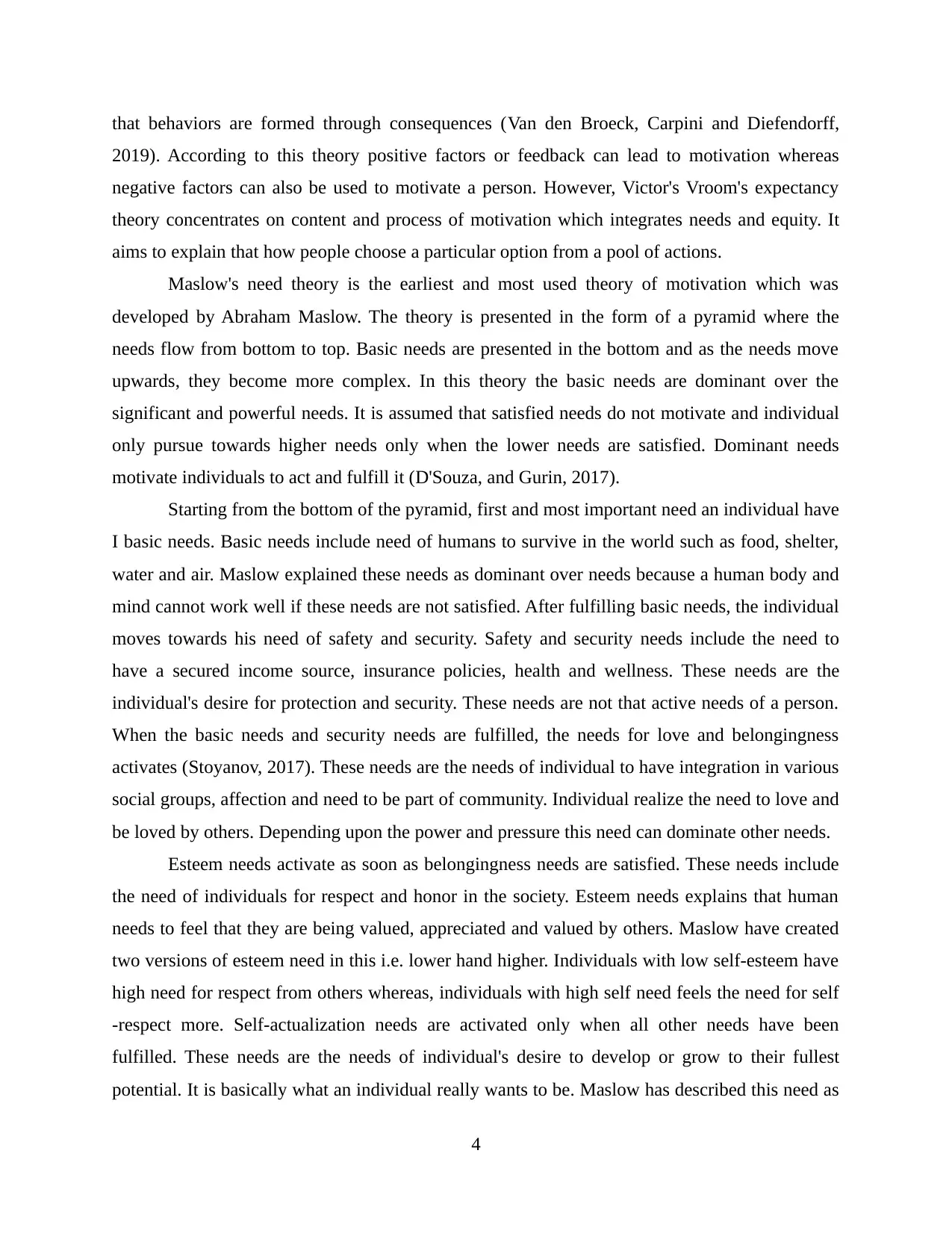
that behaviors are formed through consequences (Van den Broeck, Carpini and Diefendorff,
2019). According to this theory positive factors or feedback can lead to motivation whereas
negative factors can also be used to motivate a person. However, Victor's Vroom's expectancy
theory concentrates on content and process of motivation which integrates needs and equity. It
aims to explain that how people choose a particular option from a pool of actions.
Maslow's need theory is the earliest and most used theory of motivation which was
developed by Abraham Maslow. The theory is presented in the form of a pyramid where the
needs flow from bottom to top. Basic needs are presented in the bottom and as the needs move
upwards, they become more complex. In this theory the basic needs are dominant over the
significant and powerful needs. It is assumed that satisfied needs do not motivate and individual
only pursue towards higher needs only when the lower needs are satisfied. Dominant needs
motivate individuals to act and fulfill it (D'Souza, and Gurin, 2017).
Starting from the bottom of the pyramid, first and most important need an individual have
I basic needs. Basic needs include need of humans to survive in the world such as food, shelter,
water and air. Maslow explained these needs as dominant over needs because a human body and
mind cannot work well if these needs are not satisfied. After fulfilling basic needs, the individual
moves towards his need of safety and security. Safety and security needs include the need to
have a secured income source, insurance policies, health and wellness. These needs are the
individual's desire for protection and security. These needs are not that active needs of a person.
When the basic needs and security needs are fulfilled, the needs for love and belongingness
activates (Stoyanov, 2017). These needs are the needs of individual to have integration in various
social groups, affection and need to be part of community. Individual realize the need to love and
be loved by others. Depending upon the power and pressure this need can dominate other needs.
Esteem needs activate as soon as belongingness needs are satisfied. These needs include
the need of individuals for respect and honor in the society. Esteem needs explains that human
needs to feel that they are being valued, appreciated and valued by others. Maslow have created
two versions of esteem need in this i.e. lower hand higher. Individuals with low self-esteem have
high need for respect from others whereas, individuals with high self need feels the need for self
-respect more. Self-actualization needs are activated only when all other needs have been
fulfilled. These needs are the needs of individual's desire to develop or grow to their fullest
potential. It is basically what an individual really wants to be. Maslow has described this need as
4
2019). According to this theory positive factors or feedback can lead to motivation whereas
negative factors can also be used to motivate a person. However, Victor's Vroom's expectancy
theory concentrates on content and process of motivation which integrates needs and equity. It
aims to explain that how people choose a particular option from a pool of actions.
Maslow's need theory is the earliest and most used theory of motivation which was
developed by Abraham Maslow. The theory is presented in the form of a pyramid where the
needs flow from bottom to top. Basic needs are presented in the bottom and as the needs move
upwards, they become more complex. In this theory the basic needs are dominant over the
significant and powerful needs. It is assumed that satisfied needs do not motivate and individual
only pursue towards higher needs only when the lower needs are satisfied. Dominant needs
motivate individuals to act and fulfill it (D'Souza, and Gurin, 2017).
Starting from the bottom of the pyramid, first and most important need an individual have
I basic needs. Basic needs include need of humans to survive in the world such as food, shelter,
water and air. Maslow explained these needs as dominant over needs because a human body and
mind cannot work well if these needs are not satisfied. After fulfilling basic needs, the individual
moves towards his need of safety and security. Safety and security needs include the need to
have a secured income source, insurance policies, health and wellness. These needs are the
individual's desire for protection and security. These needs are not that active needs of a person.
When the basic needs and security needs are fulfilled, the needs for love and belongingness
activates (Stoyanov, 2017). These needs are the needs of individual to have integration in various
social groups, affection and need to be part of community. Individual realize the need to love and
be loved by others. Depending upon the power and pressure this need can dominate other needs.
Esteem needs activate as soon as belongingness needs are satisfied. These needs include
the need of individuals for respect and honor in the society. Esteem needs explains that human
needs to feel that they are being valued, appreciated and valued by others. Maslow have created
two versions of esteem need in this i.e. lower hand higher. Individuals with low self-esteem have
high need for respect from others whereas, individuals with high self need feels the need for self
-respect more. Self-actualization needs are activated only when all other needs have been
fulfilled. These needs are the needs of individual's desire to develop or grow to their fullest
potential. It is basically what an individual really wants to be. Maslow has described this need as
4
Paraphrase This Document
Need a fresh take? Get an instant paraphrase of this document with our AI Paraphraser
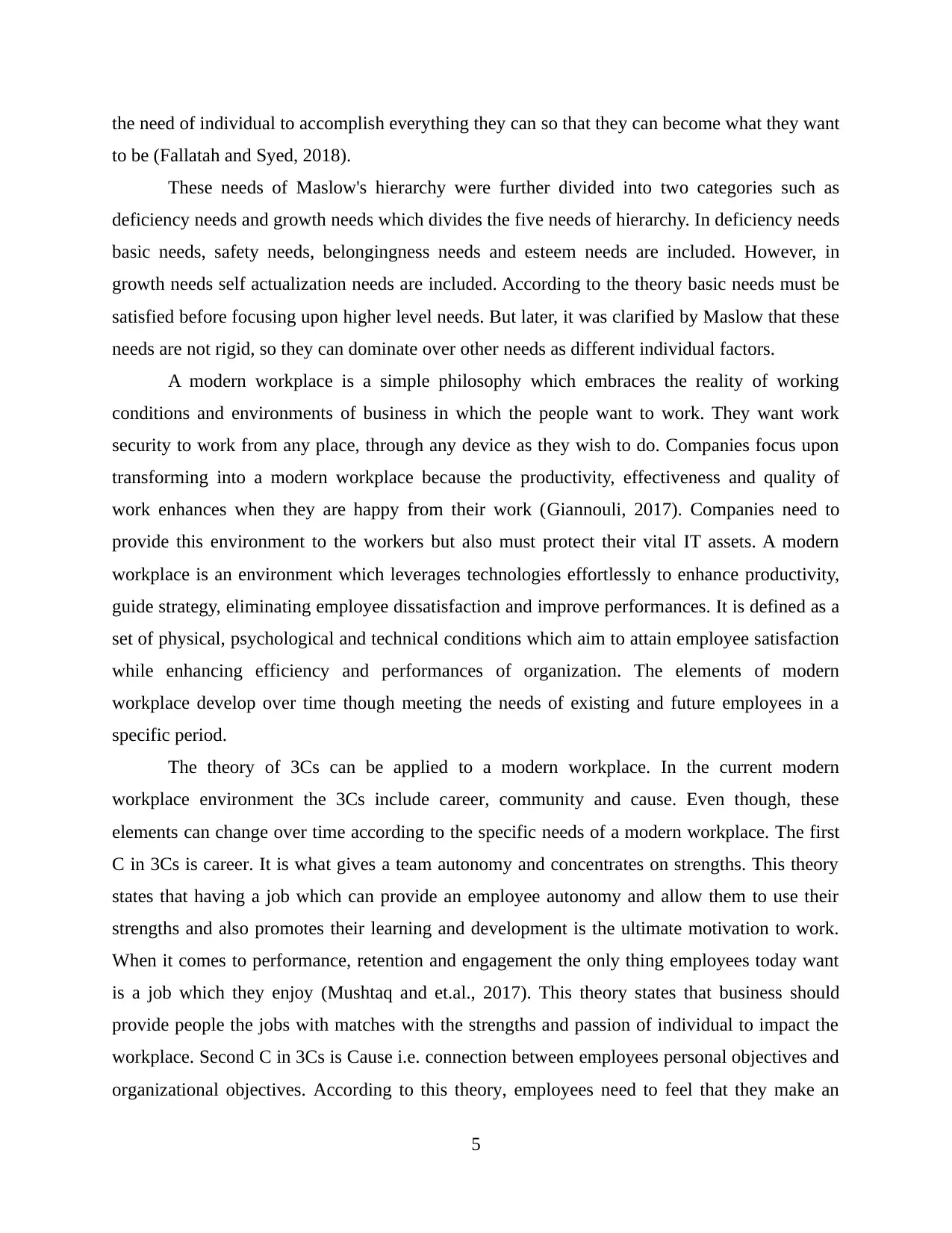
the need of individual to accomplish everything they can so that they can become what they want
to be (Fallatah and Syed, 2018).
These needs of Maslow's hierarchy were further divided into two categories such as
deficiency needs and growth needs which divides the five needs of hierarchy. In deficiency needs
basic needs, safety needs, belongingness needs and esteem needs are included. However, in
growth needs self actualization needs are included. According to the theory basic needs must be
satisfied before focusing upon higher level needs. But later, it was clarified by Maslow that these
needs are not rigid, so they can dominate over other needs as different individual factors.
A modern workplace is a simple philosophy which embraces the reality of working
conditions and environments of business in which the people want to work. They want work
security to work from any place, through any device as they wish to do. Companies focus upon
transforming into a modern workplace because the productivity, effectiveness and quality of
work enhances when they are happy from their work (Giannouli, 2017). Companies need to
provide this environment to the workers but also must protect their vital IT assets. A modern
workplace is an environment which leverages technologies effortlessly to enhance productivity,
guide strategy, eliminating employee dissatisfaction and improve performances. It is defined as a
set of physical, psychological and technical conditions which aim to attain employee satisfaction
while enhancing efficiency and performances of organization. The elements of modern
workplace develop over time though meeting the needs of existing and future employees in a
specific period.
The theory of 3Cs can be applied to a modern workplace. In the current modern
workplace environment the 3Cs include career, community and cause. Even though, these
elements can change over time according to the specific needs of a modern workplace. The first
C in 3Cs is career. It is what gives a team autonomy and concentrates on strengths. This theory
states that having a job which can provide an employee autonomy and allow them to use their
strengths and also promotes their learning and development is the ultimate motivation to work.
When it comes to performance, retention and engagement the only thing employees today want
is a job which they enjoy (Mushtaq and et.al., 2017). This theory states that business should
provide people the jobs with matches with the strengths and passion of individual to impact the
workplace. Second C in 3Cs is Cause i.e. connection between employees personal objectives and
organizational objectives. According to this theory, employees need to feel that they make an
5
to be (Fallatah and Syed, 2018).
These needs of Maslow's hierarchy were further divided into two categories such as
deficiency needs and growth needs which divides the five needs of hierarchy. In deficiency needs
basic needs, safety needs, belongingness needs and esteem needs are included. However, in
growth needs self actualization needs are included. According to the theory basic needs must be
satisfied before focusing upon higher level needs. But later, it was clarified by Maslow that these
needs are not rigid, so they can dominate over other needs as different individual factors.
A modern workplace is a simple philosophy which embraces the reality of working
conditions and environments of business in which the people want to work. They want work
security to work from any place, through any device as they wish to do. Companies focus upon
transforming into a modern workplace because the productivity, effectiveness and quality of
work enhances when they are happy from their work (Giannouli, 2017). Companies need to
provide this environment to the workers but also must protect their vital IT assets. A modern
workplace is an environment which leverages technologies effortlessly to enhance productivity,
guide strategy, eliminating employee dissatisfaction and improve performances. It is defined as a
set of physical, psychological and technical conditions which aim to attain employee satisfaction
while enhancing efficiency and performances of organization. The elements of modern
workplace develop over time though meeting the needs of existing and future employees in a
specific period.
The theory of 3Cs can be applied to a modern workplace. In the current modern
workplace environment the 3Cs include career, community and cause. Even though, these
elements can change over time according to the specific needs of a modern workplace. The first
C in 3Cs is career. It is what gives a team autonomy and concentrates on strengths. This theory
states that having a job which can provide an employee autonomy and allow them to use their
strengths and also promotes their learning and development is the ultimate motivation to work.
When it comes to performance, retention and engagement the only thing employees today want
is a job which they enjoy (Mushtaq and et.al., 2017). This theory states that business should
provide people the jobs with matches with the strengths and passion of individual to impact the
workplace. Second C in 3Cs is Cause i.e. connection between employees personal objectives and
organizational objectives. According to this theory, employees need to feel that they make an
5
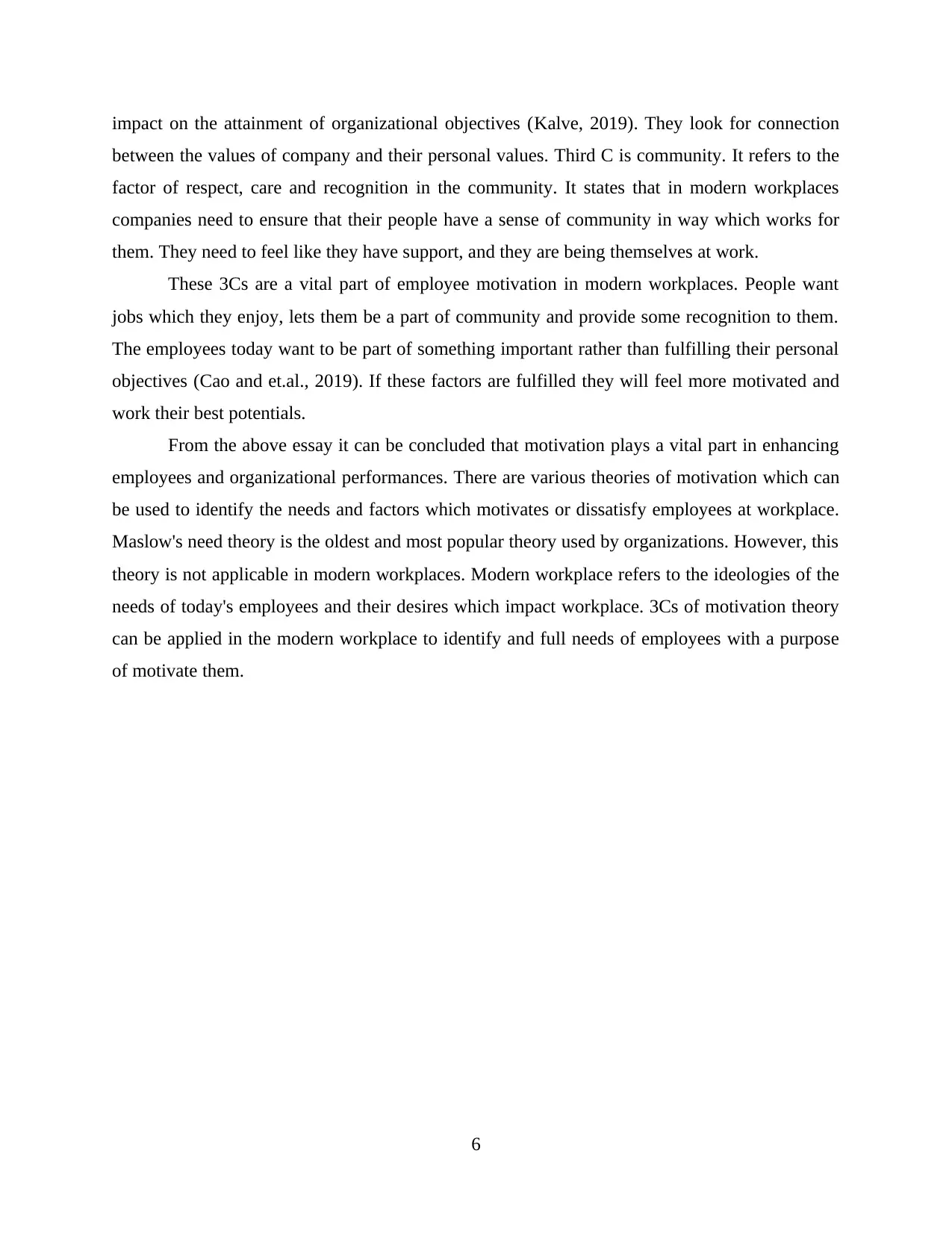
impact on the attainment of organizational objectives (Kalve, 2019). They look for connection
between the values of company and their personal values. Third C is community. It refers to the
factor of respect, care and recognition in the community. It states that in modern workplaces
companies need to ensure that their people have a sense of community in way which works for
them. They need to feel like they have support, and they are being themselves at work.
These 3Cs are a vital part of employee motivation in modern workplaces. People want
jobs which they enjoy, lets them be a part of community and provide some recognition to them.
The employees today want to be part of something important rather than fulfilling their personal
objectives (Cao and et.al., 2019). If these factors are fulfilled they will feel more motivated and
work their best potentials.
From the above essay it can be concluded that motivation plays a vital part in enhancing
employees and organizational performances. There are various theories of motivation which can
be used to identify the needs and factors which motivates or dissatisfy employees at workplace.
Maslow's need theory is the oldest and most popular theory used by organizations. However, this
theory is not applicable in modern workplaces. Modern workplace refers to the ideologies of the
needs of today's employees and their desires which impact workplace. 3Cs of motivation theory
can be applied in the modern workplace to identify and full needs of employees with a purpose
of motivate them.
6
between the values of company and their personal values. Third C is community. It refers to the
factor of respect, care and recognition in the community. It states that in modern workplaces
companies need to ensure that their people have a sense of community in way which works for
them. They need to feel like they have support, and they are being themselves at work.
These 3Cs are a vital part of employee motivation in modern workplaces. People want
jobs which they enjoy, lets them be a part of community and provide some recognition to them.
The employees today want to be part of something important rather than fulfilling their personal
objectives (Cao and et.al., 2019). If these factors are fulfilled they will feel more motivated and
work their best potentials.
From the above essay it can be concluded that motivation plays a vital part in enhancing
employees and organizational performances. There are various theories of motivation which can
be used to identify the needs and factors which motivates or dissatisfy employees at workplace.
Maslow's need theory is the oldest and most popular theory used by organizations. However, this
theory is not applicable in modern workplaces. Modern workplace refers to the ideologies of the
needs of today's employees and their desires which impact workplace. 3Cs of motivation theory
can be applied in the modern workplace to identify and full needs of employees with a purpose
of motivate them.
6
⊘ This is a preview!⊘
Do you want full access?
Subscribe today to unlock all pages.

Trusted by 1+ million students worldwide
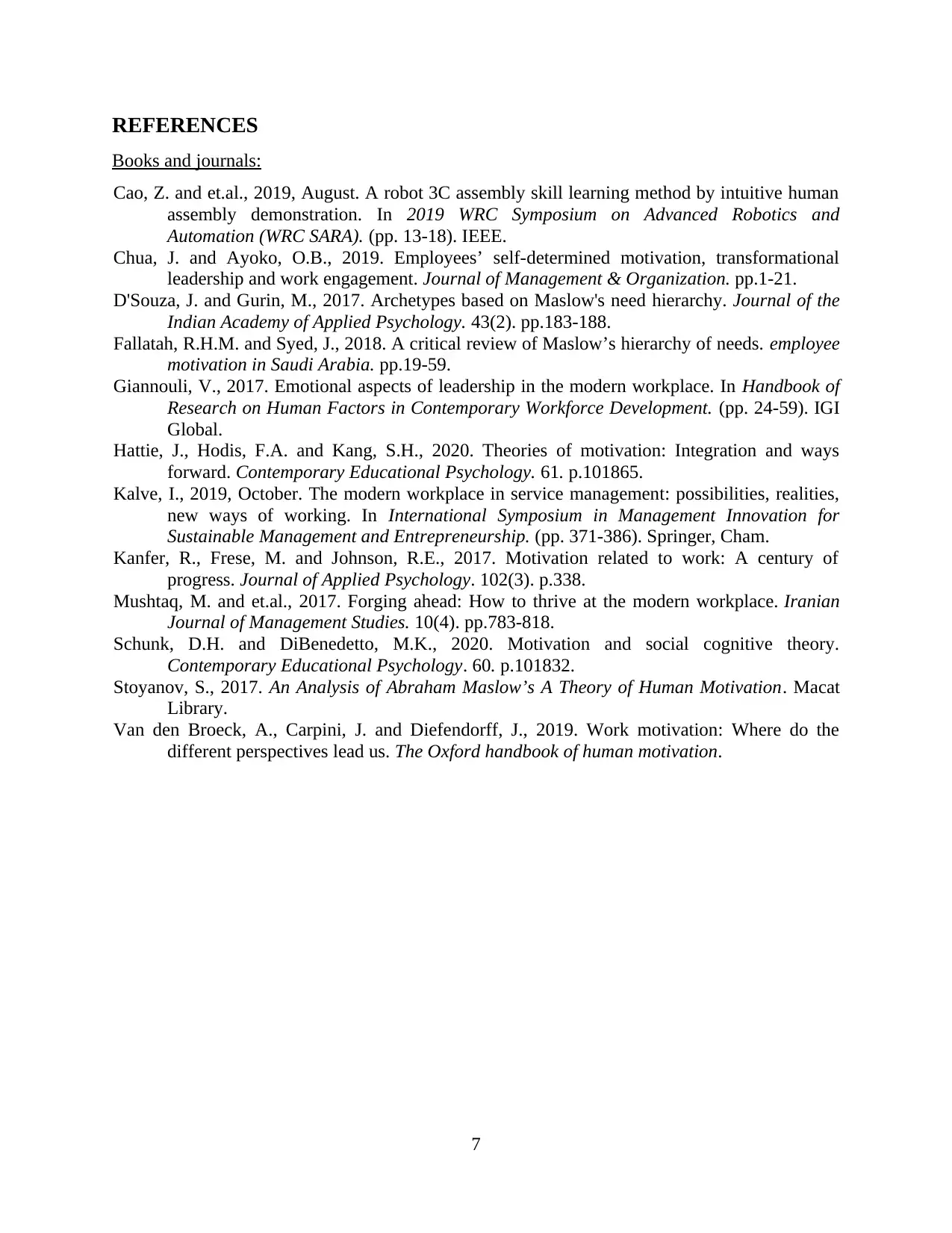
REFERENCES
Books and journals:
Cao, Z. and et.al., 2019, August. A robot 3C assembly skill learning method by intuitive human
assembly demonstration. In 2019 WRC Symposium on Advanced Robotics and
Automation (WRC SARA). (pp. 13-18). IEEE.
Chua, J. and Ayoko, O.B., 2019. Employees’ self-determined motivation, transformational
leadership and work engagement. Journal of Management & Organization. pp.1-21.
D'Souza, J. and Gurin, M., 2017. Archetypes based on Maslow's need hierarchy. Journal of the
Indian Academy of Applied Psychology. 43(2). pp.183-188.
Fallatah, R.H.M. and Syed, J., 2018. A critical review of Maslow’s hierarchy of needs. employee
motivation in Saudi Arabia. pp.19-59.
Giannouli, V., 2017. Emotional aspects of leadership in the modern workplace. In Handbook of
Research on Human Factors in Contemporary Workforce Development. (pp. 24-59). IGI
Global.
Hattie, J., Hodis, F.A. and Kang, S.H., 2020. Theories of motivation: Integration and ways
forward. Contemporary Educational Psychology. 61. p.101865.
Kalve, I., 2019, October. The modern workplace in service management: possibilities, realities,
new ways of working. In International Symposium in Management Innovation for
Sustainable Management and Entrepreneurship. (pp. 371-386). Springer, Cham.
Kanfer, R., Frese, M. and Johnson, R.E., 2017. Motivation related to work: A century of
progress. Journal of Applied Psychology. 102(3). p.338.
Mushtaq, M. and et.al., 2017. Forging ahead: How to thrive at the modern workplace. Iranian
Journal of Management Studies. 10(4). pp.783-818.
Schunk, D.H. and DiBenedetto, M.K., 2020. Motivation and social cognitive theory.
Contemporary Educational Psychology. 60. p.101832.
Stoyanov, S., 2017. An Analysis of Abraham Maslow’s A Theory of Human Motivation. Macat
Library.
Van den Broeck, A., Carpini, J. and Diefendorff, J., 2019. Work motivation: Where do the
different perspectives lead us. The Oxford handbook of human motivation.
7
Books and journals:
Cao, Z. and et.al., 2019, August. A robot 3C assembly skill learning method by intuitive human
assembly demonstration. In 2019 WRC Symposium on Advanced Robotics and
Automation (WRC SARA). (pp. 13-18). IEEE.
Chua, J. and Ayoko, O.B., 2019. Employees’ self-determined motivation, transformational
leadership and work engagement. Journal of Management & Organization. pp.1-21.
D'Souza, J. and Gurin, M., 2017. Archetypes based on Maslow's need hierarchy. Journal of the
Indian Academy of Applied Psychology. 43(2). pp.183-188.
Fallatah, R.H.M. and Syed, J., 2018. A critical review of Maslow’s hierarchy of needs. employee
motivation in Saudi Arabia. pp.19-59.
Giannouli, V., 2017. Emotional aspects of leadership in the modern workplace. In Handbook of
Research on Human Factors in Contemporary Workforce Development. (pp. 24-59). IGI
Global.
Hattie, J., Hodis, F.A. and Kang, S.H., 2020. Theories of motivation: Integration and ways
forward. Contemporary Educational Psychology. 61. p.101865.
Kalve, I., 2019, October. The modern workplace in service management: possibilities, realities,
new ways of working. In International Symposium in Management Innovation for
Sustainable Management and Entrepreneurship. (pp. 371-386). Springer, Cham.
Kanfer, R., Frese, M. and Johnson, R.E., 2017. Motivation related to work: A century of
progress. Journal of Applied Psychology. 102(3). p.338.
Mushtaq, M. and et.al., 2017. Forging ahead: How to thrive at the modern workplace. Iranian
Journal of Management Studies. 10(4). pp.783-818.
Schunk, D.H. and DiBenedetto, M.K., 2020. Motivation and social cognitive theory.
Contemporary Educational Psychology. 60. p.101832.
Stoyanov, S., 2017. An Analysis of Abraham Maslow’s A Theory of Human Motivation. Macat
Library.
Van den Broeck, A., Carpini, J. and Diefendorff, J., 2019. Work motivation: Where do the
different perspectives lead us. The Oxford handbook of human motivation.
7
1 out of 7
Related Documents
Your All-in-One AI-Powered Toolkit for Academic Success.
+13062052269
info@desklib.com
Available 24*7 on WhatsApp / Email
![[object Object]](/_next/static/media/star-bottom.7253800d.svg)
Unlock your academic potential
Copyright © 2020–2025 A2Z Services. All Rights Reserved. Developed and managed by ZUCOL.




